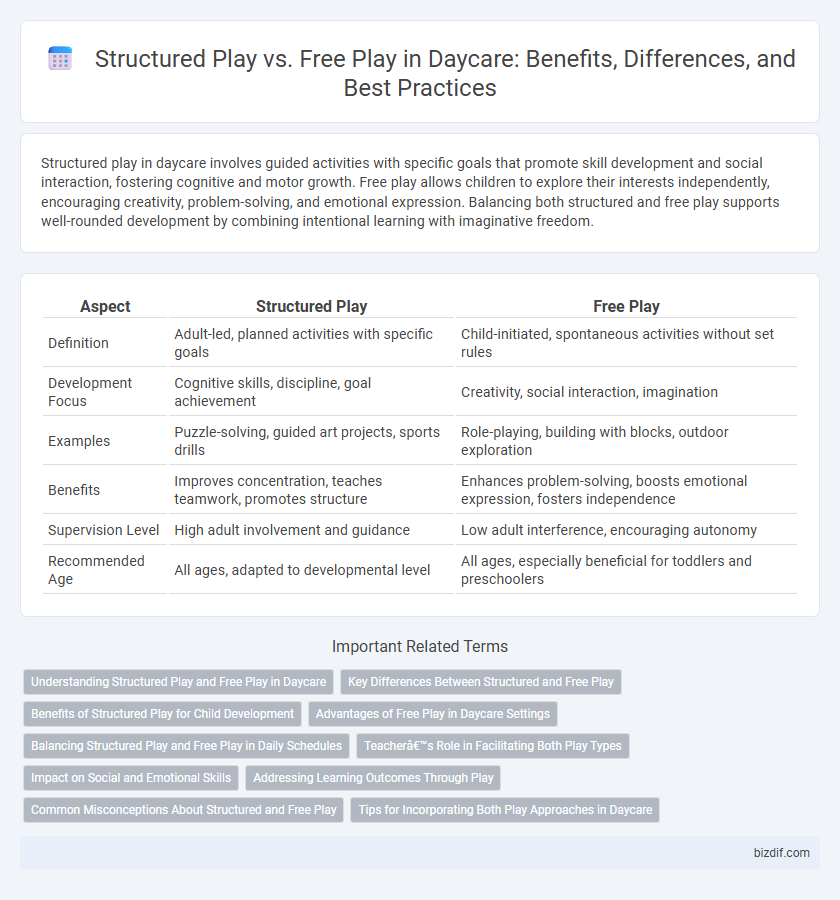Structured play in daycare involves guided activities with specific goals that promote skill development and social interaction, fostering cognitive and motor growth. Free play allows children to explore their interests independently, encouraging creativity, problem-solving, and emotional expression. Balancing both structured and free play supports well-rounded development by combining intentional learning with imaginative freedom.
Table of Comparison
| Aspect | Structured Play | Free Play |
|---|---|---|
| Definition | Adult-led, planned activities with specific goals | Child-initiated, spontaneous activities without set rules |
| Development Focus | Cognitive skills, discipline, goal achievement | Creativity, social interaction, imagination |
| Examples | Puzzle-solving, guided art projects, sports drills | Role-playing, building with blocks, outdoor exploration |
| Benefits | Improves concentration, teaches teamwork, promotes structure | Enhances problem-solving, boosts emotional expression, fosters independence |
| Supervision Level | High adult involvement and guidance | Low adult interference, encouraging autonomy |
| Recommended Age | All ages, adapted to developmental level | All ages, especially beneficial for toddlers and preschoolers |
Understanding Structured Play and Free Play in Daycare
Structured play in daycare involves guided activities designed to develop specific skills such as cognitive, social, and motor abilities, following a caregiver-led plan. Free play allows children to explore their creativity and independence by choosing activities that interest them, fostering problem-solving and self-regulation. Balancing structured play with free play supports holistic child development by combining intentional skill-building with spontaneous exploration.
Key Differences Between Structured and Free Play
Structured play in daycare involves planned activities guided by caregivers or educators, emphasizing specific skills such as social interaction, language development, and physical coordination. Free play allows children to explore and create independently, fostering creativity, decision-making, and emotional regulation without predefined rules. The key differences lie in adult involvement, goal orientation, and the balance between skill-building and imaginative exploration.
Benefits of Structured Play for Child Development
Structured play in daycare environments enhances child development by promoting cognitive skills such as problem-solving, memory, and attention through guided activities. It supports social development by encouraging cooperative interaction, turn-taking, and adherence to rules, fostering emotional regulation and communication. Furthermore, structured play aids motor skill refinement, laying a foundation for academic readiness and overall growth.
Advantages of Free Play in Daycare Settings
Free play in daycare settings enhances creativity and problem-solving skills by allowing children to explore their interests without predefined rules. It supports social development as children negotiate roles, share materials, and collaborate naturally in unstructured environments. This type of play fosters independence and self-regulation, critical for emotional growth and cognitive flexibility.
Balancing Structured Play and Free Play in Daily Schedules
Balancing structured play and free play in daycare daily schedules promotes comprehensive child development by combining guided learning with creativity and autonomy. Incorporating scheduled activities like arts, music, or group games alongside ample unstructured time encourages social skills, problem-solving, and emotional regulation. Strategic planning ensures children benefit from safety and routine in structured play while exploring imagination and independence during free play.
Teacher’s Role in Facilitating Both Play Types
Teachers play a crucial role in facilitating both structured play and free play by creating an environment that balances guided activities with opportunities for spontaneous exploration. During structured play, educators provide clear instructions and objectives that promote cognitive and social development, while in free play, they observe and gently support children's choices to foster creativity and independence. Effective daycare programs integrate teacher-led interventions and child-initiated play, ensuring comprehensive developmental benefits.
Impact on Social and Emotional Skills
Structured play in daycare settings promotes the development of social skills such as sharing, cooperation, and following rules by providing guided interactions and clear expectations. Free play fosters emotional skills including creativity, self-regulation, and problem-solving by allowing children to express themselves independently within a flexible environment. Balancing structured and free play enhances overall social-emotional growth, supporting children's ability to navigate relationships and manage emotions effectively.
Addressing Learning Outcomes Through Play
Structured play in daycare environments targets specific learning outcomes by incorporating guided activities that develop cognitive, social, and motor skills. Free play fosters creativity and problem-solving by allowing children to explore their interests in an unstructured setting, enhancing emotional and social development. Balancing structured and free play ensures comprehensive growth, supporting language acquisition, cooperation, and critical thinking abilities in early childhood education.
Common Misconceptions About Structured and Free Play
Common misconceptions about structured and free play in daycare settings often underestimate the developmental benefits of each approach. Structured play is sometimes viewed as overly rigid, but it actually promotes critical skills such as cooperation, following instructions, and cognitive development through guided activities. Conversely, free play is mistaken for unproductive time, while it fosters creativity, independence, and social interaction by allowing children to explore and make decisions autonomously.
Tips for Incorporating Both Play Approaches in Daycare
Incorporate structured play by scheduling activities like puzzles and group games that develop specific skills such as problem-solving and social interaction. Balance this with free play periods that encourage creativity and independent choice, allowing children to explore and express themselves naturally. Use themed play zones to seamlessly transition between structured tasks and open-ended play, supporting diverse developmental needs in daycare settings.
Structured Play vs Free Play Infographic

 bizdif.com
bizdif.com